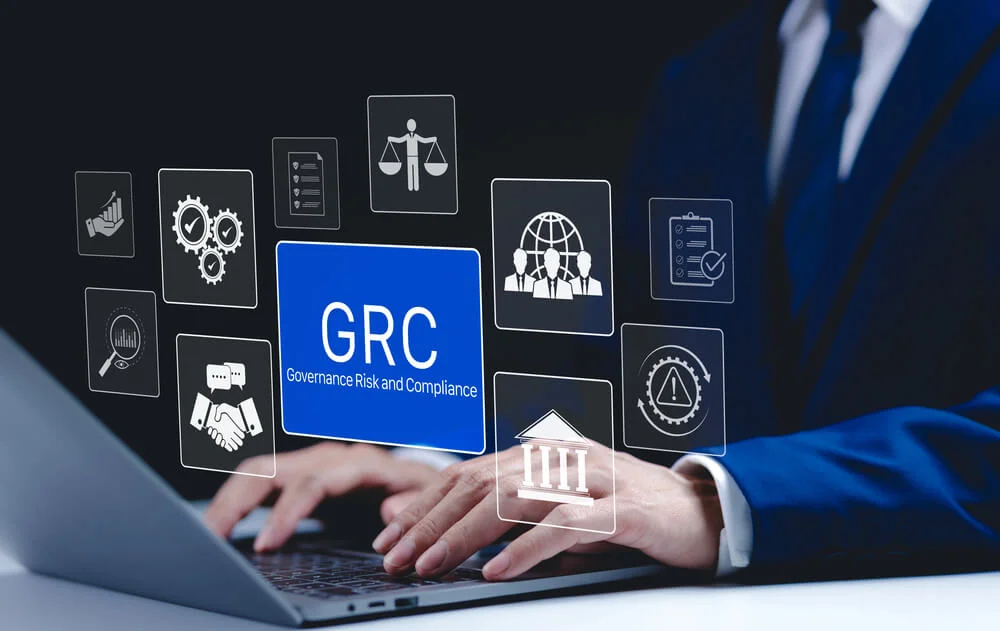In an era defined by rapid technological advancements and an increasingly interconnected world, businesses face an ever-expanding array of risks. Mitigating these risks has become a critical priority for organizations across industries. Traditionally, risk management has relied on manual processes and fragmented approaches, leading to inefficiencies and blind spots. However, the emergence of Governance, Risk, and Compliance (GRC) tools like Compyl has revolutionized the way businesses manage risk.

Why Use a GRC?
GRC represents a paradigm shift in risk management by providing an integrated framework for addressing governance, risk, and compliance concerns within a single platform. It offers several compelling reasons for organizations to adopt it:
- Holistic Approach: GRC solutions consolidate risk management activities, enabling organizations to streamline processes, improve visibility, and enhance decision-making by considering risks comprehensively across the enterprise. Due to this visibility, Compyl has seen an increase in risk awareness and more efficient risk treatment. With the cost of cybercrime rising 10% over the past year to $9.44m per breach, early intervention is critical to prevention.
- Improved Efficiency: Manual risk management processes are time-consuming, error-prone, and resource-intensive. GRC tools automate various tasks, such as risk assessment, control monitoring, and compliance tracking, allowing businesses to allocate resources more efficiently. In March 2023, Forbes reported a shortage of 700,000 unfilled security and compliance positions in the US, efficiency is critical to weather the storm of a lack of experienced resources.
- Regulatory Compliance: With an increasing number of regulations and compliance requirements, organizations must proactively monitor and ensure adherence. GRC platforms simplify compliance management by centralizing compliance efforts, generating audit trails, and facilitating reporting. CSO Online reports that 66% of companies expect spending to be driven by compliance mandates through 2023 and 2024. The general trend shows significant uptake in automated compliance and risk to reduce resource dependence on mandated activities.
- Enhanced Risk Intelligence: GRC tools offer real-time monitoring capabilities and advanced analytics, empowering businesses to proactively identify emerging risks, assess their potential impacts, and develop effective mitigation strategies.

How are Businesses Typically Managing Risk?
Traditional risk management approaches often involve manual processes and disparate systems, leading to several challenges:
- Siloed Risk Management: Different departments within an organization may adopt isolated risk management strategies, resulting in fragmented data, limited visibility, and difficulty in identifying cross-functional risks. A 2023 survey of more than 1,000 IT risk, compliance, and security professionals found a significant correlation between silos and data breaches. Specifically that companies operating with their risk management and compliance operations data in silos experienced a higher frequency of breaches.
- Manual Effort: Manual risk management processes, such as spreadsheet-based risk assessments and manual control monitoring, are labor-intensive, time-consuming, and prone to human error, hindering efficiency. This usually comes from risk managers, audit management teams, and senior management that all manage risk differently.
- Lack of Integration: Traditional methods lack integration between risk management, compliance, and governance functions, leading to inefficiencies and an incomplete view of risk exposure.
- Inadequate Reporting: Generating comprehensive risk reports manually can be challenging, often leading to delayed insights, incomplete data, and difficulty presenting information to stakeholders.
Common Threats to Businesses:
Businesses face a wide range of threats that can impact their operations, reputation, and bottom line. Some common threats include:
- Cybersecurity Risks: The proliferation of digital technologies has exposed organizations to cyber threats, including data breaches, ransomware attacks, and intellectual property theft. eSentire report that cybercrime cost will increase to $10.5 trillion by 2025. This risk breakdown isn’t just ransomware, with approximately 84% of code bases with active vulnerabilities.
- Regulatory Non-Compliance: Organizations must comply with many industry-specific regulations and data protection laws. Failure to do so can result in financial penalties, reputational damage, and legal consequences. Post-COVID-19, there has been an underlying trend of increased regulatory and government compliance requirements across all industries.
- Business Interruptions: Disruptions caused by natural disasters, supply chain failures, or unexpected events can lead to significant financial losses and operational setbacks.
- Reputational Damage: Negative publicity, social media backlash, or unethical behavior can damage a company’s reputation, impacting customer trust, stakeholder confidence, and long-term viability. 2023 has severely damaged exposed organizations such as the Guardian newspaper, Royal Mail, Linkedin (2021), Facebook (2019), and even Tesla.

The benefit of Managing Risk through a GRC Tool:
Investing in a GRC tool to manage cyber risk offers several cost-effective advantages:
- Early Threat Detection: GRC tools provide real-time monitoring and threat intelligence capabilities, allowing businesses to identify potential cyber threats early. This proactive approach helps mitigate risks before they escalate into major incidents. Other than cost benefits from a reduced staffing requirement, threat detection and response significantly reduce the potential of a threat to turn into a breach.
- Improved Incident Response: GRC tools enable organizations to develop incident response plans, automate incident tracking, and facilitate collaboration among response teams. By reducing the time to detect and respond to cyber incidents, businesses can minimize a breach’s financial and reputational impact.
- Regulatory Compliance Efficiency: GRC platforms centralize compliance efforts, automating the monitoring and reporting of regulatory requirements. This streamlines compliance processes increases accuracy, reduces the risk of penalties, and saves costs associated with manual compliance management.
- Resource Optimization: GRC tools automate manual tasks, such as risk assessments, control monitoring, and reporting. This frees up resources that can be redirected towards more strategic activities, ultimately improving operational efficiency and cost-effectiveness.
- Enhanced Risk Mitigation: GRC solutions provide a comprehensive view of risks across the organization, enabling businesses to prioritize mitigation efforts based on potential impacts. By focusing resources on high-risk areas, organizations can reduce the likelihood and severity of cyber incidents, leading to cost savings in the long run.
- Reputation Preservation: Effectively managing cyber risks through a GRC tool helps preserve the organization’s reputation. By demonstrating proactive risk management practices and maintaining compliance with data protection regulations, businesses can instill confidence in customers, partners, and stakeholders, safeguarding their brand value.
In today’s rapidly evolving business landscape, traditional risk management approaches are no longer sufficient to address the complex and interconnected risks organizations face. The adoption of GRC tools offers a compelling solution by providing a holistic, integrated, and automated approach to risk management, specifically in the context of cyber risk. By leveraging a GRC platform, businesses can achieve improved efficiency, enhanced risk intelligence, regulatory compliance, and ultimately, cost savings. Embracing GRC is a strategic step towards unlocking business resilience in the face of evolving threats and ensuring long-term success in a dynamic and interconnected world.




